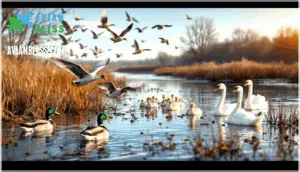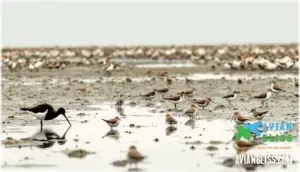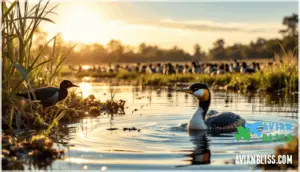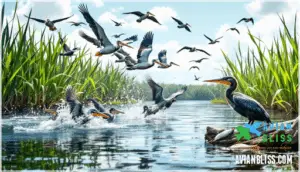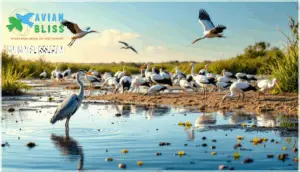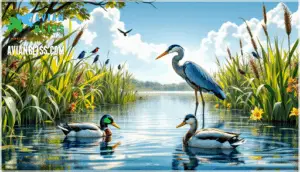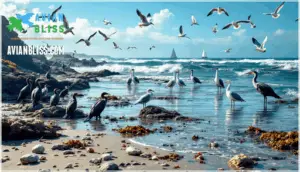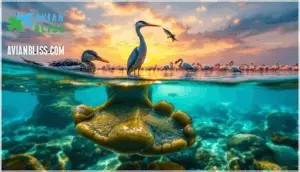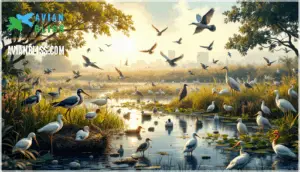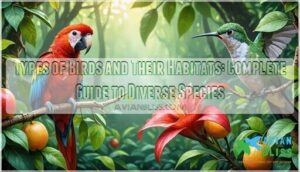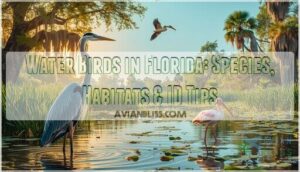This site is supported by our readers. We may earn a commission, at no cost to you, if you purchase through links.
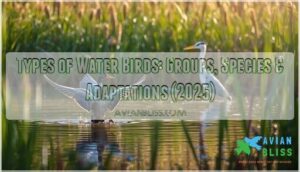 A Mallard glides across a pond, barely rippling the surface, while a Great Blue Heron stands motionless in the shallows nearby. These scenes feel familiar, yet they showcase two dramatically different approaches to life on the water.
A Mallard glides across a pond, barely rippling the surface, while a Great Blue Heron stands motionless in the shallows nearby. These scenes feel familiar, yet they showcase two dramatically different approaches to life on the water.
Water birds occupy an astonishing range of aquatic environments, from Arctic coastlines to tropical swamps, and they’ve evolved specialized features to match. Over 870 waterbird species exist worldwide, each adapted to specific habitats and feeding styles. Some dive deep for fish, others filter-feed in mudflats, and many migrate thousands of miles between breeding and wintering grounds.
Understanding the major groups of water birds reveals how evolution has solved the same challenge—thriving in wet environments—in remarkably diverse ways.
Table Of Contents
- Key Takeaways
- What Are Water Birds?
- Major Groups of Water Birds
- Freshwater Water Bird Species
- Coastal and Marine Water Birds
- Unique Adaptations of Water Birds
- Water Bird Conservation and Diversity
- Frequently Asked Questions (FAQs)
- What is a water bird?
- What are the different types of birds?
- What are the different types of water birds?
- What birds live in water?
- What is a synonym of waterbird?
- What is a waterbird example?
- What kind of birds hang around water?
- What is the most aquatic bird?
- What is a bird that lives in the water?
- What are the rarest water birds?
- Conclusion
Key Takeaways
- Water birds comprise over 870 species across 10+ taxonomic orders, each showing specialized adaptations like webbed feet, waterproof feathers, and varied bill shapes that solve the challenge of thriving in aquatic environments from Arctic coastlines to tropical wetlands.
- These birds serve critical ecosystem roles by cycling nutrients through wetlands, dispersing seeds across 10+ km between fragmented habitats, and acting as bioindicators of environmental health, though 68% of North American shorebird species have declined 37% since the 1970s.
- Major groups include waterfowl (ducks, geese, swans), waders and shorebirds, diving birds (grebes, cormorants, pelicans), and long-legged hunters (herons, storks, ibises), each using distinct feeding strategies from filter-feeding to spear-fishing to deep-diving up to 565 meters.
- Conservation challenges stem from habitat loss affecting 57% of significant wetlands, climate change altering migration timing and breeding success, and pollution threats, though restoration efforts like the North American Wetlands Conservation Act have recovered 30 million acres of critical habitat.
What Are Water Birds?
Water birds are a diverse group of species that have adapted to live in and around aquatic environments, from rivers and lakes to marshes and coastal areas. They belong to several distinct orders, including ducks and geese (Anseriformes), herons and storks (Ciconiiformes), and pelicans and cormorants (Pelecaniformes).
Let’s explore what defines these birds, their key physical traits, and the important roles they play in their ecosystems.
Definition and Classification
Water birds, or aquatic birds, are species that live on or around water in both freshwater and marine environments. According to the Ramsar Convention, any bird ecologically dependent on wetlands qualifies as a waterbird. You’ll find these birds organized across more than 10 taxonomic orders, including Anseriformes, Charadriiformes, and Pelecaniformes.
Global estimates identify over 870 waterbird species worldwide, grouped by their habitat dependence and bird taxonomy for conservation. Many water birds, including ducks, geese, and swans, favor fresh water.
Common Physical Characteristics
You’ll notice aquatic birds share several adaptations that help them thrive in water. Body density runs 5–15% lower than terrestrial species, which gives waterfowl natural buoyancy. Feather waterproofing comes from preen gland oils that create water repellency angles over 120°, keeping birds dry while they swim.
Beak morphology varies widely—ducks have flat bills for filtering, while herons sport long, pointed beaks for spearing fish. Webbed feet provide the thrust for locomotion, with about 85% of water birds using this design.
Sensory adaptations include enhanced retinal density and dual-focus vision, allowing cormorants to see clearly underwater and in air. These birds showcase various anatomical features suited to their lifestyle.
Ecological Role of Water Birds
Beyond these adaptations, aquatic birds act as ecosystem engineers you mightn’t expect. Waterfowl and other water birds drive nutrient cycling by redistributing nitrogen and phosphorus through excretion, which fuels plant growth across wetlands. They also excel at seed dispersal, moving aquatic vegetation over 10 km between habitats. Their ecological role extends to bioindication uses, pest control through invertebrate predation, and cultural services like ecotourism.
Here’s what they do:
- Transfer nutrients between feeding and roosting sites, boosting productivity
- Disperse seeds of 88+ plant species, connecting fragmented wetlands
- Regulate mosquito larvae and crop pests, protecting human health
Major Groups of Water Birds
Water birds fall into several major groups based on their evolutionary relationships and physical traits. Scientists organize these birds into distinct orders, each with unique adaptations for aquatic life.
You’ll find five primary groups that make up the majority of water birds you might encounter near rivers, lakes, wetlands, and coastal areas.
Waterfowl (Ducks, Geese, Swans)
You’ll find waterfowl—members of Anatidae within Anseriformes—wherever wetlands support life, from Arctic tundra to temperate lakes. This diverse group includes ducks, geese, and swans, with over 170 species worldwide relying on wetland ecosystems for survival.
These birds provide essential ecosystem services, dispersing seeds, cycling nutrients through nitrogen-rich waste, and serving as bioindicators of wetland health.
| Group | Migration Pattern | Population Status (2025) |
|---|---|---|
| Ducks | Variable; some travel 5,000 km routes | 34 million breeding pairs in North America |
| Geese | V-formation flocks at 50 mph | Stable, with coordinated monitoring programs |
| Swans | Pairs or small groups, energy-intensive flight | Partially migratory depending on climate |
Waders and Shorebirds
Along coastal mudflats and inland wetlands, you’ll encounter shorebirds—a diverse group of aquatic birds adapted to life at water’s edge. These waders display striking feeding adaptations, from specialized bills to long legs that allow foraging at varying depths.
Shorebird migration patterns span hemispheres, with population trends showing concerning declines: 68% of North American species lost 37% of individuals since the 1970s, making conservation status assessment critical for bird identification efforts and protection of these vulnerable water birds in their varied wader habitats.
Shorebird populations have plummeted dramatically, with 68% of North American species losing over a third of their numbers since the 1970s
Grebes, Coots, and Rails
Among freshwater aquatic birds, grebes, coots, and rails represent three distinct families adapted to wetland life. Habitat preferences vary widely: grebes favor lakes with emergent plants, rails need shallow wetlands, and coots thrive in larger reservoirs. You’ll recognize grebes by their diving prowess in open water, while rails skulk through dense marsh vegetation, and coots forage across lake surfaces.
Feeding behavior differs too—grebes dive for fish and invertebrates, coots eat vegetation and small animals, and rails hunt aquatic insects. Population trends reveal serious conservation concerns: Horned Grebes declined 57% from 1970–2019, and Black Rails lost over half their global population in 50 years. Threats include wetland loss from agriculture, climate-induced droughts, and sea-level rise affecting coastal populations. Conservation status ranges from stable for some coots to threatened for eastern Black Rails, making wetland protection essential for these pressured water birds.
| Bird Group | Primary Habitat | Conservation Concern |
|---|---|---|
| Grebes | Open lakes with vegetation | Horned Grebe: -57% decline |
| Rails | Dense marsh vegetation | Black Rail: 50%+ loss |
| Coots | Large freshwater lakes | Moderate recent declines |
Pelicans, Cormorants, and Darters
Within the order Pelecaniformes, pelicans, cormorants, and darters share a unique trait: totipalmate feet with all four toes webbed. You’ll spot them using different fishing strategies—pelicans sweep fish into their throat pouches cooperatively, cormorants dive over 20 meters chasing prey, and darters spear fish then surface for their distinctive wing-drying behavior.
Habitat overlap in wetlands lets these water bird species boost catch rates, though conservation status varies from stable populations to threatened Oriental Darters facing wetland loss across aquatic bird habitats.
Herons, Ibises, and Storks
Herons, ibises, and storks within order Pelecaniformes rely on specialized adaptations you’ll recognize across freshwater and coastal aquatic bird habitats. These water bird classification groups showcase distinct foraging techniques and habitat use:
- Herons use stand-and-wait strikes in shallow wetlands, with Grey Herons nesting in colonies called heronries
- Ibises probe mudflats with curved bills, like the Northern Bald Ibis climbing to "Endangered" status after hitting 500 individuals in 2024
- Storks migrate long distances, with White Stork populations jumping 100% across Europe since 2014
Despite conservation gains, habitat threats from wetland drainage still challenge nesting colonies and migration patterns globally.
Freshwater Water Bird Species
Freshwater habitats support some of the most diverse and recognizable water birds you’ll encounter. Rivers, lakes, ponds, and wetlands provide essential resources for species ranging from dabbling ducks to secretive rails.
Here’s a closer look at the key freshwater water bird groups and the species that make these habitats home.
Ducks (e.g., Mallard, Wood Duck)
You’ll find ducks among the most adaptable waterfowl, with species like the mallard and wood duck thriving in diverse freshwater habitats.
Mallards use four major migration flyways and can travel up to 800 miles in a single flight, though their eastern North American population has declined 9% since 2016.
Wood ducks prefer wooded swamps and beaver ponds, nesting in tree cavities within a mile of water, with their highest concentrations found along North Carolina’s Coastal Plain year-round.
Swans (e.g., Black Swan, Mute Swan)
Swans rank among the largest and most graceful waterfowl, with the black swan (Cygnus atratus) and mute swan (Cygnus olor) representing distinct species with unique adaptations. You’ll notice these water bird species in different swan habitats worldwide:
- Swan Taxonomy: Both belong to family Anatidae, genus Cygnus, with black swans measuring 110–142 cm and mute swans reaching 140–160 cm in length.
- Swan Diets: These herbivores consume 3–4 kg of aquatic vegetation daily, plunging their necks up to 1 m deep.
- Swan Reproduction: Breeding occurs February–September for black swans and March–June for mute swans, with monogamous pairs building massive nests.
- Swan Conservation: Global populations remain stable at 165,000–180,000 black swans and 600,000–700,000 mute swans, both classified as "Least Concern.
Geese (e.g., Canada Goose, Snow Goose)
Geese represent highly social waterfowl species, with Canada Goose (Branta canadensis) and Snow Goose populations exhibiting distinct migration patterns and ecological impacts across North America.
You’ll observe these waterfowl species in diverse habitats, from Arctic tundra to urban parks, where their management policies address climate effects on breeding success and population dynamics.
Canada Geese now total approximately 7 million individuals as of mid-2024, demonstrating considerable adaptability to human-modified landscapes.
Rails, Coots, and Crakes
While geese dominate open grasslands, you’ll find the secretive Rallidae family—including rails, coots, and crakes—tucked into dense marsh vegetation and shallow wetlands.
These members of Gruiformes have laterally compressed bodies and long toes for traversing reeds, with coots displaying lobed feet for swimming and common moorhens foraging among aquatic plants.
Water rails exhibit territorial behavior, while their reproductive biology shows monogamous pairs building floating nests that support considerable weight.
Coastal and Marine Water Birds
Coastal and marine environments support a different set of water birds than inland waters, with species adapted to salt water, tides, and open shorelines. You’ll find birds here that have developed specialized skills for fishing in surf, diving deep for prey, or probing mudflats for invertebrates.
The following groups represent the major types of coastal and marine water birds you’re likely to encounter.
Gulls and Terns
You’ll recognize gulls and terns along coastlines worldwide, where these aquatic birds display distinct behaviors and adaptations. Gulls, grouped primarily within the genus Larus, are generalist feeders consuming fish, invertebrates, and even urban waste, while terns dive precisely from flight to catch fish near the surface.
Over 50 gull species and 44 tern species inhabit marine and freshwater environments, though population declines threaten several taxa—Great Black-backed Gulls declined nearly 43% between 1985 and 2021, and conservation efforts now focus on habitat restoration and monitoring breeding success.
Pelicans and Cormorants
Pelicans and cormorants share piscivorous lifestyles but employ different foraging behaviors. Pelicans scoop fish from the surface using expandable throat pouches holding up to 3 gallons, while double-crested cormorants pursue prey underwater, diving 10–45 meters with denser bones for buoyancy control.
American White Pelican populations are stable across interior North America, but conservation status varies:
- Brown Pelicans recovered from endangerment after DDT bans, delisted in 2009
- Brandt’s Cormorants face coastal declines from disturbance and reduced prey
- Habitat distribution spans freshwater lakes, rivers, and marine coastlines globally
- Taxonomy evolution places both groups within Suliformes, with 8 pelican and 40 cormorant species worldwide
Physical adaptations include cormorants’ specialized preen glands producing less waterproofing oil, enhancing underwater hunting efficiency. These water bird adaptations reflect millions of years of ecological specialization.
Shorebirds (e.g., Sandpipers, Avocets)
Shorebirds like Semipalmated Sandpipers and Pied Avocets belong to Charadriiformes, waders adapted to coastal flats and mudflats.
Over 70% of North American migratory shorebirds face population decline from habitat loss, including Black-Necked Stilts along Atlantic shores. Climate adaptation allows some species to adjust nesting times, yet conservation efforts struggle as sea level rise eliminates breeding grounds.
Migration patterns span over 10,000 km, making shore habitat protection critical for recovery.
Storks and Herons
Within Ciconiiformes, storks and herons demonstrate distinct morphology adapted to their water bird habitats. You’ll notice storks possess stout, straight bills for grasping prey, while heron morphology features dagger-shaped bills for spearing fish.
Migration patterns have shifted dramatically—climate change reduced stork migration distances by 40%, with many overwintering in Spain rather than Africa.
Conservation efforts like Denmark’s White Stork Project achieved considerable success, recording 33 nestlings in 2025, the highest since the 1980s, demonstrating effective habitat restoration.
Unique Adaptations of Water Birds
Water birds have developed impressive physical and behavioral traits that allow them to thrive in aquatic environments. These adaptations range from specialized body structures to clever hunting methods and survival strategies.
Let’s explore the key features that make water birds so well-suited to life in and around water.
Webbed Feet and Specialized Bills
If you’ve ever wondered how water birds glide effortlessly through lakes and rivers, the answer lies in their striking physical adaptations. Webbed feet and specialized bills work together like a perfectly tuned machine, letting these avian physical features meet the challenges of aquatic life.
- Webbing Evolution: Webbed feet evolved independently across multiple bird lineages, with webbing morphology varying from partial (palmate) to complete (totipalmate) depending on species
- Hydrodynamic Function: These water bird characteristics increase surface area by up to 60%, creating propulsive force similar to aircraft wing designs during swimming
- Bill Morphology: Specialized bills show broad, flattened shapes for filter feeding, with aquatic feeders having twice the mechanoreceptors of terrestrial birds
- Muscular Adaptations: Diving birds invest 20–40% more in foot musculature than terrestrial species, supporting powerful swimming strokes
- Feeding Ecology: The co-evolution of webbed feet and bills enhances niche differentiation, allowing water birds to exploit diverse aquatic food sources efficiently
Feeding Techniques and Diet
You’ll find dietary diversity among water birds is truly striking, as species consume fish, molluscs, crustaceans, worms, and insects depending on habitat. Foraging strategies vary widely—dabbling ducks filter surface waters, herons hunt patiently in deeper zones, and cormorants pursue prey underwater up to 62 km from nests. Shorebirds probe mudflats for hidden prey, while ibises sweep shallow waters tactilely.
Seasonal shifts occur as avian diet changes with migration, like Red Knots switching from crustaceans to 78% bivalves when wintering.
Human influence now shapes water bird feeding habits through supplementary feeders at 20% of households globally, altering natural fish eaters and nectarivorous species’ behaviors in these habitat patterns.
Nesting and Breeding Behaviors
You’ll notice water bird nesting habits vary dramatically by species and habitat. Nesting site selection often prioritizes deeper water zones, reducing mammalian predation, while elevated terrain protects against flooding during the breeding season.
Clutch size remains consistent across years—Brown Pelicans average 2.9 eggs per nest—though incubation behavior directly influences breeding success.
Site fidelity strengthens reproductive outcomes, as female King Eiders return within 15 km of previous nesting locations annually, demonstrating how mating behaviors and water bird breeding behaviors adapt to environmental pressures.
Migration Patterns and Strategies
You might think migration is simple movement between seasons, but waterbirds rely on complex navigation mechanisms—geomagnetic cues, celestial maps, and polarized light—to traverse routes spanning 15,000 km along major flyways.
Stopover ecology proves critical, as species like Red Knots double body mass before non-stop flights exceeding 5,000 km.
Phenological shifts now challenge migratory bird behavior; Hudsonian Godwits arrive seven days later than a decade ago, illustrating how climate alters water bird migration patterns and threatens flyway conservation across interconnected waterways.
Water Bird Conservation and Diversity
Water birds face real challenges today, from shrinking wetlands to shifting climates, but understanding their global diversity helps us protect them.
Conservation efforts depend on tracking population trends, identifying threats, and recognizing which species need help most.
Let’s look at the current state of water bird populations and what you can do to support their survival.
Global Water Bird Populations
You’ll find water bird populations tracked through extensive global monitoring, with 2024 data showing 2,340 active populations across 899 avian species. Monitoring frameworks like the International Waterbird Census collect systematic observations from over 13,000 field observers in 36 countries, documenting bird migration patterns and regional distribution across major flyways.
- Population trends reveal 42% of water bird populations increasing, 33% decreasing, and 25% stable between 2012 and 2024
- Regional distribution patterns show the East Atlantic Flyway alone sustains over ten million migratory water birds annually
- Data sources from the Waterbird Populations Portal consolidate information on 2,300+ populations for scientific analysis
- Monitoring frameworks include coordinated triennial censuses that generate national biodiversity indicators
- Conservation significance emerges as these population estimates guide wetland protection under the Ramsar Convention
Threats and Conservation Efforts
Water bird populations face mounting challenges, yet conservation initiatives offer hope. Habitat degradation tops the threat list, with 112 species losing over half their populations in fifty years due to wetland destruction and agricultural conversion. Climate impacts intensify pressure through increased flooding, drought, and sea-level rise affecting 30% of coastal nesting sites.
Pollution threats emerge from microplastics, with urban water birds ingesting 15–30 particles per individual, while fertilizer runoff depletes food resources. Hunting impacts persist as illegal wildlife trade generates $200 million annually in Southeast Asia alone.
However, water bird conservation shows promise through targeted programs. Conservation initiatives like the North American Wetlands Conservation Act restored 30 million acres, demonstrating that strategic habitat protection works when you commit resources and coordinate efforts across regions.
Importance of Wetland Habitats
Behind conservation efforts lies a simple truth: wetlands are the beating heart of water bird survival. These waterway ecosystems provide irreplaceable support you can measure in tangible ways:
- Ecosystem Productivity – Wetlands sustain 40% of global species, including 138 U.S. wetland-dependent birds
- Climate Regulation – They store 44% of Earth’s soil carbon, sequestering 3.25 metric tons per hectare annually
- Migratory Support – Over 900 species rely on seasonal wetlands as stopover points along flyways
- Human Benefits – Wetlands provide $23 billion in annual flood protection while supporting commercial fisheries
- Conservation Gaps – Yet 57% of significant aquatic bird habitats lack adequate protection
Wetlands maintain the intricate balance water birds need, filtering pollutants, regulating groundwater, and offering food-rich breeding grounds. When you lose wetlands, entire populations collapse—precisely why protecting these habitats determines whether waterbirds thrive or disappear.
Notable Endangered Water Bird Species
Some species face extinction risks you can’t ignore. The Spoon-billed Sandpiper has fewer than 250 breeding pairs left, driven to the edge by habitat loss along its migration route. Madagascar pochard populations dropped below 100 individuals due to wetland drainage. Pacific seabirds face the highest extinction risks globally, while Hawaii’s endemic water birds continue declining despite conservation efforts.
Habitat destruction, invasive species, and water pollution compound these threats, making targeted conservation efforts urgent for species survival.
Frequently Asked Questions (FAQs)
What is a water bird?
Avian aquatic adaptations are what set these birds apart. Water birds are any species with physical traits like waterproof feathers, webbed feet, and specialized beaks that depend on aquatic habitats for survival, feeding, and breeding across diverse ecosystems.
What are the different types of birds?
Birds fall into diverse groups based on evolutionary relationships and habitat specialization, helping with bird identification across avian species. You’ll find waterfowl, raptors, songbirds, seabirds, and more—each showing distinct behavioral differences shaped by where they live and what they eat.
What are the different types of water birds?
You’ll encounter multiple groups of water birds across different habitats. Waterfowl like ducks and swans thrive in freshwater, while waders and shorebirds patrol coastlines.
Grebes, pelicans, and herons each belong to distinct taxonomic orders, showcasing significant habitat diversity and evolutionary relationships that shape avian classification and species identification worldwide.
What birds live in water?
You’ll find hundreds of aquatic bird species living in water environments worldwide, from freshwater lakes and rivers to coastal shores and open oceans.
These waterbird adaptations include webbed feet, waterproof feathers, and specialized bills for catching fish or filtering food from water bird habitats.
What is a synonym of waterbird?
You’ll often hear "aquatic bird" used interchangeably with waterbird, since both describe species that thrive in water environments.
Other synonyms include waterfowl, wading bird, shorebird, and seabird, though each term highlights different water bird species and their specific habitats.
What is a waterbird example?
You know what they say: seeing is believing, and water birds offer plenty to observe. A classic waterbird example is the mallard duck, with males displaying iridescent green heads and adaptations for aquatic life.
Great Blue Herons demonstrate heron hunting patience in shallow waters, while American White Pelicans showcase specialized pelican diet strategies through group fishing.
These bird species represent the diversity of water bird identification across habitats—from swan behavior in still ponds to ibis habitat preferences in marshlands—illustrating how aquatic birds have evolved distinct water bird behavior patterns for survival.
What kind of birds hang around water?
You’ll encounter a wide array of water birds, including ducks, geese, swans, herons, pelicans, cormorants, rails, coots, and shorebirds like sandpipers and avocets.
All these birds are adapted to aquatic habitats, with specialized features for feeding and survival.
What is the most aquatic bird?
Emperor Penguins reign as the foremost aquatic aviators, plunging nearly 565 meters deep and holding their breath for up to 27 minutes.
These exceptional water birds rely on dense bones, oxygen-rich blood, and flipper propulsion to navigate underwater worlds where most avian species can’t venture.
What is a bird that lives in the water?
Ducks, geese, swans, herons, and pelicans are water birds that live in aquatic habitats. You’ll find these bird species in rivers, lakes, wetlands, and coastal areas, where their specialized avian adaptations help them thrive in waterbird habitats.
What are the rarest water birds?
Around 389 bird species face extinction from climate impacts, with some water birds declining over 80%. The rarest include the White-winged Flufftail and Madagascar Pochard, both critically endangered due to habitat loss, pollution, and climate change threatening their wetland homes.
Conclusion
Next time you spot a bird near water, pause. Is it diving, wading, or skimming the surface? Each behavior reveals a story written over millions of years.
The types of water birds you encounter—whether a cormorant drying its wings or a sandpiper probing mud—represent evolution’s countless solutions to a single challenge: making a living where land meets water.
Their diversity isn’t just fascinating; it’s a reminder that adaptation takes infinite forms, and every wetland holds secrets worth protecting.
- https://www.ramsar.org/sites/default/files/2024-03/SC63_20_waterbird_population_estimates_e.pdf
- https://www.waddensea-worldheritage.org/news/new-report-shows-current-trends-migratory-waterbird-populations-east-atlantic-flyway
- https://www.fws.gov/story/migratory-bird-annual-status-reports
- https://www.sciencedirect.com/science/article/pii/S1470160X21009511
- https://www.birdscaribbean.org/our-work/caribbean-waterbird-census-program/

